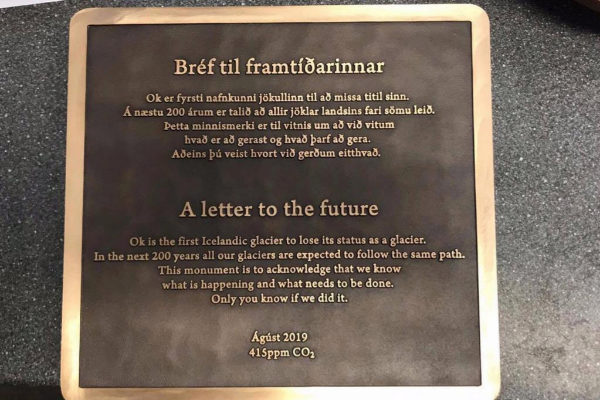- Pollution: Plastic falling from the sky: tiny particles are found even in the Arctic snow
- Climate: Last July was the hottest month on the entire planet since there are records
Okjokull, Iceland's first glacier that lost its range devoured by global warming , has just been honored with a commemorative plaque, an opportunity for scientists to warn about the consequences of climate change.
The plaque was presented this Sunday afternoon at the place occupied by Okjokull (literally "Ok glacier" in Icelandic ), in the west of the island.
"I hope this ceremony will be a source of inspiration not only for us here in Iceland but also for the rest of the world, because what we see here is only part of the climate crisis ," Iceland's Prime Minister Katrín told Afp Jakobsdóttir, who delivered a short speech.
With the gold-plated plaque titled in Icelandic and in English "A letter for the future," researchers hope to raise public awareness about glacier decline and the effects of climate change.
It also bears the mention "415 ppm CO2", referring to the record level of concentration of parts per million of carbon dioxide recorded in the atmosphere last May.
"Remembering a lost glacier, we want to focus on what is disappearing - or dying - in the whole world, and call attention to the fact that it is something 'accomplished' by men , although not we should be proud of it, "Cymene Howe, a professor of anthropology at Rice University in the United States, said in a statement.
"Discussions on climate change can be very abstract, accompanied by numerous catastrophic statistics and complex and incomprehensible scientific models," he added.
According to the researcher and her colleague Dominic Boyer, Iceland loses about eleven billion tons of ice per year . Scientists fear the disappearance of the nearly 400 glaciers that the subarctic island has in the next 200 years.
Okjokull ice, which covered 16 km2 of surface in 1890, no longer occupied more than 0.7 km2 in 2012, according to a report from the University of Iceland in 2017.
In 2014, " we made the decision that it was no longer a glacier , it was just dead ice that was not moving," says geologist Oddur Sigurdsson, who studied Okjokull. Then the glacier was degraded, a first in Iceland.
To have the range of glacier the mass of ice and snow " must be thick enough to be able to move thanks to its own weight," that is, 40 to 50 meters thick to produce a sufficient pressure to return to malleable ice, he explains .
Losses with the current pace
Nearly half of the world heritage sites could lose their glaciers by 2100 if greenhouse gas emissions continue at their current pace, according to a study by the International Union for Conservation of Nature (IUCN) published in April.
Oddur Sigurdsson says he fears "that nothing can be done to stop" those disappearances.
"The inertia of the climate system is such that, with greenhouse effect in the atmosphere, it would continue to reheat for a century and a half or two before reaching its equilibrium," he says.
In Iceland, the Vatnajokull National Park, in the south of the island and inscribed on the UNESCO World Heritage since July, is named after the glacier it houses and still retains the title of the largest ice cap in Europe.
According to the criteria of The Trust Project
Know more- Europe
- UNESCO
- Climate change
Climate changeInvisible refugees and "traumatic migrations", the climate change that millions already suffer worldwide
Climate change Ecologists require the Basque Government to advance carbon neutrality by 2040
Wide angle The reason Donald Trump wants to buy Greenland from Denmark

